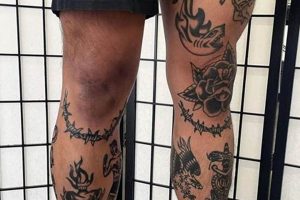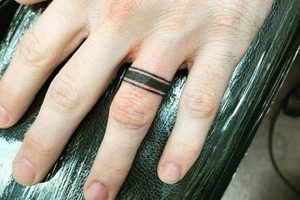Small, intricate designs, bold tribal patterns, symbolic imagery, and realistic portraits are just a few examples of the diverse artwork applicable to hand tattoos for men. Placement considerations include the back of the hand, fingers, knuckles, and the palm, each offering a unique canvas for self-expression.
Hand tattoos offer a powerful form of personal expression, readily visible and capable of conveying messages, beliefs, or simply aesthetic appreciation. Historically, hand tattoos held cultural and societal significance in various communities, often symbolizing status, affiliations, or spiritual beliefs. Today, they remain a prominent choice for those seeking a visible and enduring art form.
The following sections will explore various styles, design considerations, practical advice related to pain management and aftercare, and responsible decision-making regarding hand tattoos.
Tips for Hand Tattoos
Careful consideration is crucial when selecting a hand tattoo due to its high visibility and potential impact on professional and social perceptions. The following tips offer guidance for making informed decisions.
Tip 1: Consider Visibility and Professional Impact: Hand tattoos are immediately noticeable. Individuals in careers with strict dress codes or client-facing roles should carefully evaluate the potential consequences before proceeding.
Tip 2: Research Artists Specializing in Hand Tattoos: The hand’s complex anatomy and thin skin require a skilled artist experienced in this specific area. Thorough research and portfolio review are essential.
Tip 3: Choose Meaningful Designs: Given their prominence, hand tattoos are often best suited for designs with significant personal meaning, reflecting values, beliefs, or important life events.
Tip 4: Plan for Pain and Aftercare: Hand tattoos can be more painful than tattoos on other body parts. Prepare for a potentially uncomfortable experience and commit to diligent aftercare to ensure proper healing.
Tip 5: Think Long-Term: Hand tattoos are exposed to frequent wear and tear, potentially requiring more touch-ups than tattoos in other locations. Factor this into long-term maintenance considerations.
Tip 6: Start Small: For first-time hand tattoos, a smaller, simpler design allows for assessment of pain tolerance and aesthetic preferences before committing to larger, more complex pieces.
Tip 7: Discuss Placement Carefully with Your Artist: Different hand areas offer varying levels of visibility and suitability for specific designs. Consult with your artist to determine the optimal placement.
Following these guidelines increases the likelihood of a positive and fulfilling hand tattoo experience, ensuring a well-executed, meaningful, and enduring piece of art.
By carefully considering design, placement, artist selection, and aftercare, individuals can make informed choices that lead to successful and satisfying hand tattoos.
1. Placement
Placement is a critical factor in hand tattoo design. The hand’s unique anatomy and constant visibility necessitate careful consideration of how a design interacts with its curves, joints, and overall form. A tattoo that wraps seamlessly around a finger differs significantly from one strategically positioned on the back of the hand. The choice of placement impacts not only the aesthetic but also the practical aspects of the tattoo, including wear and tear, sun exposure, and potential fading.
For instance, a small, minimalist design might suit the side of a finger, while a larger, more intricate piece could be positioned across the knuckles or the back of the hand. A name tattooed on the inside of a finger carries a different level of intimacy than a bold design displayed prominently on the top of the hand. The curvature of the hand requires designs that flow naturally with its contours, avoiding distortions or awkward placement that could detract from the overall aesthetic. Practical considerations also come into play, as areas exposed to more frequent friction, like the palm or fingertips, may experience faster fading.
Ultimately, optimal placement maximizes the visual impact of the design, complementing the hand’s natural form and ensuring the tattoo remains aesthetically pleasing over time. Careful planning and consultation with an experienced tattoo artist are essential to navigate these considerations and achieve a well-executed and visually satisfying result. Understanding the interplay between design and placement is crucial for a successful hand tattoo that embodies both artistic vision and practical longevity.
2. Size and Style
Size and style are integral components of hand tattoo design, significantly influencing the overall aesthetic and conveying different messages. Careful consideration of these elements is essential for creating a visually appealing and personally meaningful tattoo that harmonizes with the hand’s anatomy.
- Minimalist Designs
Minimalist tattoos, characterized by clean lines and simple imagery, are well-suited for smaller spaces on the hand, such as the fingers or the side of the palm. These designs often feature geometric shapes, small symbols, or single words, offering a subtle yet impactful statement. Their simplicity allows for precise execution, crucial for areas where the skin is thin and delicate. Examples include single-line drawings, small Roman numerals, or minimalist depictions of animals or objects.
- Intricate Patterns
Intricate patterns, like mandalas, geometric designs, or tribal art, can cover larger portions of the hand, creating visually captivating displays. These complex designs require a skilled artist to ensure precision and clarity, especially given the hand’s uneven surface. The level of detail and the chosen pattern can reflect cultural heritage, personal interests, or abstract artistic expression. Examples include Maori or Polynesian tribal patterns, detailed floral designs, or intricate geometric weaves.
- Realism and Portraits
Realistic depictions of people, animals, or objects require significant space and a high level of artistic skill. Due to the hand’s limited surface area, realistic tattoos are typically reserved for larger areas like the back of the hand. The success of these designs hinges on the artist’s ability to capture intricate details and create a lifelike representation. Examples include portraits of loved ones, detailed depictions of animals, or realistic renderings of objects like watches or flowers.
- Typography and Lettering
Words, phrases, or quotes can be impactful hand tattoos, ranging from single letters to longer inscriptions. Font selection, size, and placement contribute significantly to the overall aesthetic. Script fonts offer an elegant look, while bold block letters create a more assertive statement. The chosen words can represent personal mottos, names of loved ones, or significant dates, carrying personal meaning and serving as a constant reminder. Examples include names tattooed on the fingers, short quotes along the side of the hand, or single words representing core values.
The interplay between size and style ultimately determines the visual impact and longevity of a hand tattoo. Choosing a design that complements the hand’s anatomy and reflects personal preferences ensures a meaningful and aesthetically pleasing result. Considering the practicalities of hand placement, like visibility and potential wear and tear, further refines the decision-making process, leading to a tattoo that stands the test of time.
3. Symbolism and Meaning
Symbolism plays a crucial role in hand tattoos, elevating them from mere decoration to powerful personal statements. Hand placement amplifies the visibility of chosen symbols, broadcasting their significance to the world. This inherent visibility encourages careful selection of imagery, prompting individuals to choose symbols resonant with deeply held values, beliefs, or experiences. The symbolic weight of a hand tattoo can stem from cultural heritage, personal narratives, or universal archetypes, transforming the hand into a canvas that tells a story.
For example, a Hamsa hand symbolizes protection and good fortune across various cultures, making it a popular choice for hand tattoos. Similarly, animals carry rich symbolic meaning, with lions representing strength and courage, eagles signifying freedom and vision, and wolves embodying loyalty and family. Religious iconography, such as crosses, Om symbols, or Buddha images, allows individuals to express spiritual beliefs. Geometric patterns, often rooted in ancient traditions, can represent balance, harmony, or interconnectedness. Even seemingly simple designs, like anchors or compasses, can hold profound personal meaning, symbolizing stability, direction, or a connection to the sea.
Understanding the cultural and historical context of chosen symbols is paramount, ensuring respectful representation and avoiding unintended misinterpretations. A skilled tattoo artist can provide valuable insights into symbolic meanings and assist in translating personal narratives into visually compelling designs. Ultimately, the interplay between symbolism and placement transforms hand tattoos into potent forms of self-expression, reflecting individual identities and beliefs for the world to see. By carefully considering the symbolic resonance of chosen imagery, individuals imbue their hand tattoos with lasting meaning and significance.
4. Practicality and Aftercare
Practicality and aftercare are paramount considerations for hand tattoos due to their unique challenges. Hands are constantly exposed to the elements, frequent washing, and potential abrasion, increasing the risk of infection and impacting ink longevity. Understanding these practical implications before getting a hand tattoo is crucial for ensuring proper healing and maintaining the design’s integrity. Neglecting aftercare can lead to faded ink, blurred lines, and even scarring. For example, consistent moisturizing is essential to prevent excessive dryness and cracking, which can damage the tattoo. Sun exposure, another significant factor, necessitates diligent sunscreen application to minimize fading and discoloration.
Practical considerations also extend to lifestyle and profession. Certain occupations involving manual labor or frequent hand washing may require additional precautions to protect the tattoo during the healing process and beyond. Individuals in such professions should consider the potential impact on their work and discuss appropriate protective measures with their tattoo artist. Furthermore, the visibility of hand tattoos carries social implications that individuals must consider before committing to the design. While societal acceptance of tattoos has grown, certain professional settings may still hold reservations. Understanding these potential challenges allows for informed decisions that align with personal and professional circumstances.
Diligent aftercare, including regular washing with mild soap, consistent moisturizing, and sun protection, is essential for preserving the vibrancy and clarity of hand tattoos. Open communication with the tattoo artist regarding specific aftercare instructions tailored to the individual’s skin type and lifestyle further optimizes healing and long-term maintenance. Acknowledging the practical realities of hand tattoos, from healing challenges to professional and social considerations, empowers individuals to make informed decisions and ensure a positive and lasting outcome.
5. Artist Selection
Selecting the right artist is paramount when considering a hand tattoo. Given the hand’s prominent visibility and the intricacies of tattooing this area, an artist’s skill and experience directly impact the final result. Choosing an artist specializing in the desired style and possessing a strong portfolio of hand tattoos ensures a well-executed, aesthetically pleasing, and long-lasting piece.
- Specialization and Style
Different artists specialize in various tattoo styles. For intricate geometric patterns, seek an artist with proven precision and experience in that area. Similarly, realistic portraiture demands a different skill set than traditional or neo-traditional styles. Reviewing an artist’s portfolio provides valuable insight into their strengths and suitability for the desired hand tattoo design. Matching artistic style with personal preference is crucial for a satisfying outcome. For example, an artist specializing in black and grey realism might not be the best choice for a vibrant, watercolor-style hand tattoo.
- Experience with Hand Tattoos
The hand presents unique challenges for tattooing due to thin skin, intricate bone structure, and frequent movement. An experienced hand tattoo artist understands these challenges and possesses the technical expertise to navigate them effectively. They can advise on appropriate design choices, placement considerations, and aftercare specific to hand tattoos, ensuring optimal healing and longevity. Their experience translates into cleaner lines, better ink saturation, and a minimized risk of complications.
- Hygiene and Professionalism
Maintaining high hygiene standards is crucial in any tattooing practice, but especially so for hand tattoos due to their increased exposure to potential contaminants. A reputable artist adheres to strict sterilization procedures, uses single-use needles and equipment, and maintains a clean and sanitary workspace. Professionalism extends beyond hygiene, encompassing clear communication, respectful consultations, and a commitment to client satisfaction. Thorough research and observation of the artist’s studio environment provide valuable insights into their commitment to hygiene and professional practices.
- Reviews and Recommendations
Seeking reviews and recommendations from previous clients offers valuable insights into an artist’s skill, professionalism, and overall client experience. Online platforms, social media, and personal referrals provide access to firsthand accounts of other individuals’ experiences with a particular artist. These reviews can shed light on aspects like the artist’s communication style, pain management techniques, and the long-term quality of their work. This information empowers informed decision-making and increases the likelihood of a positive experience.
By carefully considering these factors, individuals seeking a hand tattoo can select an artist whose skills, experience, and artistic vision align with their personal preferences. This careful selection process contributes significantly to the success and longevity of the tattoo, ensuring a piece of art that not only looks visually appealing but also heals well and stands the test of time. A well-chosen artist acts as a collaborative partner, guiding the individual through the process and creating a hand tattoo that reflects their unique style and story.
Frequently Asked Questions
This section addresses common inquiries regarding hand tattoos, providing factual information to facilitate informed decision-making.
Question 1: How much do hand tattoos typically cost?
Pricing varies based on design complexity, size, artist experience, and geographic location. Obtaining quotes from multiple reputable artists is recommended.
Question 2: Are hand tattoos more painful than tattoos on other body parts?
Due to the thin skin and proximity to bone, hand tattoos are generally considered more painful than tattoos in other areas. Individual pain tolerance also plays a significant role.
Question 3: How long do hand tattoos take to heal?
Healing time typically ranges from two to four weeks, influenced by factors such as individual healing rates, aftercare diligence, and overall health.
Question 4: Do hand tattoos fade faster than tattoos in other locations?
Due to frequent hand washing and sun exposure, hand tattoos are susceptible to faster fading. Diligent aftercare and sun protection minimize this effect.
Question 5: What are the potential career implications of having a hand tattoo?
Certain professions maintain stricter dress codes regarding visible tattoos. Individuals should research industry standards and consider potential career impacts before getting a hand tattoo.
Question 6: Can hand tattoos be covered up or removed?
Covering a hand tattoo with makeup is challenging due to frequent hand movement and washing. Laser removal is an option but requires multiple sessions and may not completely erase the tattoo.
Careful consideration of these factors ensures individuals make informed decisions about hand tattoos, aligning aesthetic desires with practical considerations and long-term implications.
Further research and consultation with experienced tattoo artists provide additional insights and personalized guidance.
Conclusion
Careful consideration of placement, size, style, and symbolism is crucial for successful hand tattoos. Practical aspects, including pain tolerance, aftercare, and professional implications, necessitate thorough planning. Artist selection remains paramount, emphasizing experience, specialization, and hygiene practices. Addressing these factors ensures meaningful, well-executed, and enduring hand tattoos that reflect individual style and personal narratives.
Hand tattoos offer a powerful canvas for self-expression, transforming the hand into a visible testament to personal values and artistic vision. Thoughtful planning and informed decision-making empower individuals to embrace this unique art form with confidence, ensuring a result that resonates with personal meaning and withstands the test of time.







